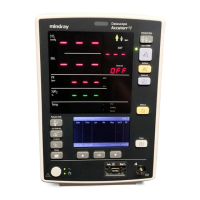SpO
2
Measurements Operation
3 - 30 0070-10-0699-02 Accutorr V Operating Instructions
CAUTION: Inaccurate readings may be caused by incorrect sensor
application or use; significant levels of dysfunctional
hemoglobins (i.e. carbohemoglobins or methemoglobin); or
intra-vascular dyes such as indocyanine green or methylene
blue; exposure to excessive illumination, such as surgical
lamps (especially ones with a Xenon light source), bilirubin
lamps, fluorescent lights, infrared heating lamps, or direct
sunlight; excessive patient movement; venous pulsations;
electro-surgical interference; and placement of a sensor on
an extremity that has a blood pressure cuff, arterial
catheter, or intra-vascular line.
CAUTION: In certain situations in which perfusion and signal strength
are low, such as in patients with thick or pigmented skin,
inaccurately low SpO2 readings will result. Verification of
oxygenation should be made, especially in preterm infants
and patients with chronic lung disease, before instituting
any therapy or intervention.
CAUTION: Prolonged and continuous monitoring may increase the risk
of skin erosion and pressure necrosis at the site of the
sensor. Check the SpO2 sensor site frequently to ensure
proper positioning, alignment, and skin integrity at least
every eight (8) hours; with the Adult and Pediatric re-usable
finger sensor, check every four (4) hours; for neonates and
patients of poor perfusion or with skin sensitive to light,
check every 2 - 3 hours; more frequent examinations may
be required for different patients. Change the sensor site if
signs of circulatory compromise occur. Ensure proper
adhesion, skin integrity, and proper alignment. Exercise
extreme caution with poorly perfused patients. When
sensors are not frequently monitored, skin erosion and
pressure necrosis can occur. Assess the site every two (2)
hours with poorly perfused patients and neonates.
CAUTION: Route cables neatly. Ensure cables, hoses, and wires are
kept away from patient’s neck to avoid strangulation. Keep
floors and walkways free of cables to reduce risk to
hospital personnel, patients, and visitors. If the sensor or
patient cable is damaged in any way, discontinue use
immediately.
NOTE: The PC Series Patient Cable is not used with the
LNOP
®
•DCSC Sensors.
NOTE: Do not place the sensor on an extremity with an invasive
catheter or blood pressure cuff in place.
The digital SpO
2
value displays on the SpO
2
LED (7), and the SpO
2
Pulse Rate displays on
the Pulse Rate LED (6).
3. If needed, adjust the beep volume. See Section 3.10.1, “Setting the Alarm Volume, Key
Volume, and Pulse Volume, and NIBP End Tone Volume”, for details on adjusting the
beep volume.

